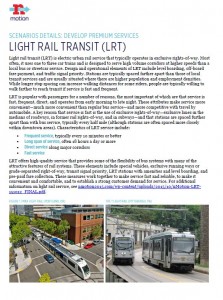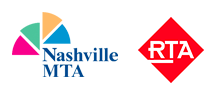Light rail transit (LRT) is electric urban rail service that typically operates in exclusive rights of way. Most often, it uses one- to three-car trains and is designed to serve high-volume corridors at higher speeds than a local bus or streetcar service. Design and operational elements of LRT include level boarding, off-board fair payment and traffic signal priority. Stations are typically spaced farther apart than those of local transit services and are usually situated where there are higher population and employment densities. While longer stop spacing can increase walking distances for some riders, people are typically willing to walk farther to reach transit if service is fast and frequent.


Light Rail was RULED OUT as too expensive when AMP (BRT) was chosen over it.
AMP was BLOCKED after it was pointed out that the $170 million AMP budget could be used to INVEST and PROFIT from by building and selling (less easements for the pathways) a “GravTrans” structure (US Patent 8322943).
GRAVTRANS is a 21st century solution. Rail is from the 19th century and Buses and BRT are from the 20th century. “Get with the times!”
I don’t know if gravtrans is a solution but I do think a 21 st century solution should have more discussion.
nMotion was very prompt and generous with creating discussion space for comments that address scenario independent aspects of the various proposals. It is a shame that my comment of March 26 is still awaiting moderation after three reminders.
It also appears the most of the crowds have left.
I am most disappointed in the Light Rail as proposed for Scenario 1. This is not what I had in mind at all. My objections to this implementation are:
–The Scenario 1 implementation takes up travel lanes in major axial arterials adding to the congestion experienced by commuters.
–The route is not a high speed route; it cannot perform safely at the limits of light rail and will not achieve transit times as fast as driving.
–The route anticipates frequent stops, as many as two per mile per the document.
–Light Rail in Scenario 1 will have essentially zero impact on congestion on Interstate 65 (N & S) and Interstate 24.
The light rail routes shown in Scenario 1 are way more expensive than the RapidBus in Scenario 3 while performing about the same. It is a very expensive “nice to have”, not a “must have”.
I was expecting a proposal similar to that expressed by the Nashville Area Metropolitan Planning Organization in their long range vision for a Bold, New Vision for Mass Transit: http://www.nashvillempo.org/plans_programs/rtp/transit_vision.aspx (without the ridiculous number of stops indicated for Rapid Transit). RTA’s challenge should be to find a way to implement a rail solution to Murfreesboro, Franklin and Gallatin that is competitive with automobile even on a good day.
I put the light rail solution that I think most people are looking for in the map at goo.gl/psRxbG Light rail operating at 65-80 mph should have stops every 4-5 miles, in my opinion. I have indicated a possible solution in the map. Notice the connections with the RapidBus route and the Crosstown Connector. The light rail stops should also be served by local service collectors.
I know what nMotion is thinking: light rail throughout Nashville will promote all kinds of high density development with walkable neighborhoods that more than cover the extra cost or rail. News Flash nMotion: unless light rail fixes the schools most of the growth in Middle Tennessee is happening outside of Davidson County. Rail needs to go to the neighboring counties because that is where the commuters are.
There are adequate development opportunities along the proposed streetcar lines (see my article under “Streetcars”) and along the several light rail stops as described in the map. There are also plenty of other suitable development sites that benefit from regular bus transit, e.g., the Southern Land development in Green Hills, the Castle Rock development on Demonbreun and the proposed Stonehenge development on Charlotte; none of which depend on rail investments. Transit needs to work as transit then the developers will take advantage.
Backing up to the big picture again: Scenario 3 (an improvement to “Modest Improvements” is described in the document linked to my name above) PLUS two Streetcar lines (as described in my “Streetcars” comments PLUS three Light Rail lines (fast with few stops) to Gallatin, Franklin and Murfreesboro. This will cost plenty but it will be money well spent; nothing is wasted.
This is a link to a map of my proposed route for light rail to Gallatin, Murfreesboro and Franklin:
https://goo.gl/psRxbG
I am most disappointed in the Light Rail as proposed for Scenario 1. This is not what I had in mind at all. My objections to this implementation are:
–The Scenario 1 implementation takes up travel lanes in major axial arterials adding to the congestion experienced by commuters.
–The route is not a high speed route; it cannot perform safely at the limits of light rail and will not achieve transit times as fast as driving.
–The route anticipates frequent stops, as many as two per mile per the document.
–Light Rail in Scenario 1 will have essentially zero impact on congestion on Interstate 65 (N & S) and Interstate 24.
The light rail routes shown in Scenario 1 are way more expensive than the RapidBus in Scenario 3 while performing about the same. It is a very expensive “nice to have”, not a “must have”.
I was expecting a proposal similar to that expressed by the Nashville Area Metropolitan Planning Organization in their long range vision for a Bold, New Vision for Mass Transit: http://www.nashvillempo.org/plans_programs/rtp/transit_vision.aspx (without the ridiculous number of stops indicated for Rapid Transit). RTA’s challenge should be to find a way to implement a rail solution to Murfreesboro, Franklin and Gallatin that is competitive with automobile even on a good day.
I put the light rail solution that I think most people are looking for in the map at https://goo.gl/psRxbG Light rail operating at 65-80 mph should have stops every 4-5 miles, in my opinion. I have indicated a possible solution in the map. Notice the connections with the RapidBus route and the Crosstown Connector. The light rail stops should also be served by local service collectors.
I know what nMotion is thinking: light rail throughout Nashville will promote all kinds of high density development with walkable neighborhoods that more than cover the extra cost or rail. News Flash nMotion: unless light rail fixes the schools most of the growth in Middle Tennessee is happening outside of Davidson County. Rail needs to go to the neighboring counties because that is where the commuters are.
There are adequate development opportunities along the proposed streetcar lines (see my article under “Streetcars”) and along the several light rail stops as described in the map. There are also plenty of other suitable development sites that benefit from regular bus transit, e.g., the Southern Land development in Green Hills, the Castle Rock development on Demonbreun and the proposed Stonehenge development on Charlotte; none of which depend on rail investments. Transit needs to work as transit then the developers will take advantage.
Backing up to the big picture again: Scenario 3 (an improvement to “Modest Improvements” is described in the document linked to my name above) PLUS two Streetcar lines (as described in my “Streetcars” comments PLUS three Light Rail lines (fast with few stops) to Gallatin, Franklin and Murfreesboro. This will cost plenty but it will be money well spent; nothing is wasted.
Do I hear an “Amen”?
Roy Wellington